The Development of ARIMA Models for the Clear Sky Beam and Diffuse Optical Depths for HVAC Systems Design Using RTSM: A Case Study of the Umlazi Township Area, South Africa
Abstract
1. Introduction
2. Materials and Methods
3. Results and Discussion
4. Application Example
5. Conclusions
Author Contributions
Funding
Data Availability Statement
Acknowledgments
Conflicts of Interest
References
- Liang, C.; Li, X.; Melikov, A.K.; Shao, X.L.; Li, B. A quantitative relationship between heat gain and local cooling load in a general non-uniform indoor environment. Energy 2019, 182, 412–423. [Google Scholar] [CrossRef]
- Chenari, B.; Carrilho, J.D.; da Silva, M.G. Towards sustainable, energy-efficient and healthy ventilation strategies in buildings: A review. Renew. Sustain. Energy Rev. 2016, 59, 1426–1447. [Google Scholar] [CrossRef]
- Toparlar, Y.; Blocken, B.; Maiheu, B. Impact of urban microclimate on summertime building cooling demand: A parametric analysis for Antwerp, Belgium. Appl. Energy 2018, 228, 852–872. [Google Scholar] [CrossRef]
- Ürge-Vorsatz, D.; Cabeza, L.F.; Serrano, S.; Barreneche, C.; Petrichenko, K. Heating and cooling energy trends and drivers in buildings. Renew. Sustain. Energy Rev. 2015, 41, 85–98. [Google Scholar] [CrossRef]
- Vakiloroaya, V.; Samali, B.; Fakhar, A. A review of different strategies for HVAC energy saving. Energy Convers. Manag. 2014, 77, 738–754. [Google Scholar] [CrossRef]
- Kabanshi, A.; Ameen, A.; Hayati, A. Cooling energy simulation and analysis of an intermittent ventilation strategy under different climates. Energy 2018, 156, 84–94. [Google Scholar] [CrossRef]
- Jing, R.; Wang, M.; Zhang, R.; Li, N.; Zhao, Y. A study on energy performance of 30 commercial office buildings in Hong Kong. Energy Build. 2017, 144, 117–128. [Google Scholar] [CrossRef]
- Yan, D.; Zhe, T.; Yong, W.; Zhu, N. Achievements and suggestions of heat metering and energy efficiency retrofit for existing residential buildings in northern heating regions of China. Energy Policy 2011, 39, 4675–4682. [Google Scholar] [CrossRef]
- Zhou, X.; Yan, D.; Hong, T.; Ren, X. Data analysis and stochastic modelling of lighting energy use in large office buildings in China. Energy Build. 2015, 86, 275–287. [Google Scholar] [CrossRef]
- Energy Technology Perspectives 2016; International Energy Agency (IEA): Paris, France, 2016; Available online: https://www.iea.org/reports/cooling (accessed on 28 February 2022).
- Kapetanakis, D.S.; Mangina, E.; Finn, D.P. Input variable selection for thermal load predictive models of commercial buildings. Energy Build. 2017, 137, 13–26. [Google Scholar] [CrossRef]
- Li, X.W.; Wen, J. Review of building energy modeling for control and operation. Renew. Sustain. Energy Rev. 2014, 37, 517–537. [Google Scholar] [CrossRef]
- Pérez-Lombard, L.; Ortiz, J.; Pout, C. A review on buildings energy consumption information. Energy Build. 2008, 40, 394–398. [Google Scholar] [CrossRef]
- Niu, J.; Tian, Z.; Lu, Y.; Zhao, H.; Lan, B. A robust optimization model for designing the building cooling source under cooling load uncertainty. Appl. Energy 2019, 241, 390–403. [Google Scholar] [CrossRef]
- Xiang-Li, L.; Zhi-Yong, R.; Lin, D. An investigation on life-cycle energy consumption and carbon emissions of building space heating and cooling systems. Renew. Energy 2015, 84, 124–129. [Google Scholar] [CrossRef]
- Macas, M.; Moretti, F.; Fonti, A.; Giantomassi, A.; Comodi, G.; Annunziato, M.; Pizzuti, S.; Capra, A. The role of data sample size and dimensionality in neural network based forecasting of building heating related variables. Energy Build. 2016, 111, 299–310. [Google Scholar] [CrossRef]
- Zainal, O.A.; Yumrutas, R. Validation of periodic solution for computing CLTD (cooling load temperature difference) values for building walls and flat roofs. Energy 2015, 82, 758–768. [Google Scholar] [CrossRef]
- Sarwar, R.; Cho, H.; Cox, S.J.; Mago, P.J.; Luck, R. Field validation study of a time and temperature indexed autoregressive with exogenous (ARX) model for building thermal load prediction. Energy 2017, 119, 483–496. [Google Scholar] [CrossRef]
- Ding, Y.; Zhang, Q.; Yuan, T. Research on short-term and ultra-short-term cooling load prediction models for office buildings. Energy Build. 2017, 154, 254–267. [Google Scholar] [CrossRef]
- Li, X.; Liu, K.; Tian, J. Variability, predictability, and uncertainty in global aerosols inferred from gap-filled satellite observations and an econometric modeling approach. Remote Sens. Environ. 2021, 261, 112501. [Google Scholar] [CrossRef]
- Yu, F.; Yue, Q.; Yunianta, A.; Aljahdali, H.M.A. A novel hybrid deep correction approach for electrical load demand prediction. Sustain. Cities Soc. 2021, 74, 103161. [Google Scholar] [CrossRef]
- Dubey, A.K.; Kumar, A.; García-Díaz, V.; Sharma, A.; Kanhaiya, K.S.S. Study and analysis of SARIMA and LSTM in forecasting time series data. Sustain. Energy Technol. Assess. 2021, 47, 101474. [Google Scholar]
- Lee, D.-S.; Jo, J.-H.; Koo, S.-H.; Lee, B. Development of Climate Indices Using Local Weather Data for Shading Design. Sustainability 2015, 7, 1884–1899. [Google Scholar] [CrossRef]
- Jannat, N.; Hussien, A.; Abdullah, B.M.; Cotgrave, A.J. A Comparative Simulation Study of the Thermal Performances of the Building Envelope Wall Materials in the Tropics. Sustainability 2020, 12, 4892. [Google Scholar] [CrossRef]
- Gou, S.; Nik, V.M.; Scartezzini, J.-L.; Zhao, Q.; Li, Z. Passive design optimization of newly-built residential buildings in Shanghai for improving indoor thermal comfort while reducing building energy demand. Energy Build. 2018, 169, 484–506. [Google Scholar] [CrossRef]
- Konstantinou, T.; Ignjatović, Ć.N.; Zbašnik-Senegačnik, M. Energy: Resources and Building Performance; TU Delft Open: Delft, The Netherlands, 2018. [Google Scholar]
- Badea, N. Design for Micro-Combined Cooling, Heating and Power Systems. In Stirling Engines and Renewable Power Systems, 1st ed.; Springer: London, UK, 2015. [Google Scholar]
- Mao, C.; Baltazar, J.-C.; Haberl, J.S. Literature review of building peak cooling load methods in the United States. Sci. Technol. Built Environ. 2018, 24, 228–237. [Google Scholar] [CrossRef]
- Lv, L.; Huang, C.; Li, L.; Chen, J. Experimental study on calculation method of the radiant time factors. Renew. Energy 2015, 73, 28–35. [Google Scholar] [CrossRef]
- Spitler, J.D.; Fisher, D.E.; Pedersen, C.O. The radiant time series cooling load calculation procedure. ASHRAE Trans. 1997, 103, 503–515. [Google Scholar]
- Spitler, J.D.; Fisher, D.E. On the Relationship between the Radiant Time Series and Transfer Function Methods for Design Cooling Load Calculations. HVAC&R Res. 1999, 5, 123–136. [Google Scholar]
- McQuiston, F.C.; Parker, J.D.; Spitler, J.D. Heating Ventilating and Air Conditioning Analysis and Design, 6th ed.; John Wiley & Sons Inc.: San Francisco, CA, USA, 2005. [Google Scholar]
- 2017 ASHRAE Handbook—Fundamentals (SI); American Society of Heating, Refrigerating and Air-Conditioning Engineers: Atlanta, GA, USA, 2017.
- Optical Depth. Wikipedia, The Free Encyclopedia. 2020. Available online: https://en.wikipedia.org/wiki/Optical_depth (accessed on 28 February 2022).
- Kim, S.-W.; Choi, I.-J.; Yoon, S.-C. A multi-year analysis of clear-sky aerosol optical properties and direct radiative forcing at Gosan. Atmos. Res. 2010, 95, 279–287. [Google Scholar] [CrossRef]
- Tang, W.; Yang, K.; Qin, J.; Niu, X.; Lin, C.; Jing, X. A revisit to decadal change of aerosol optical depth and its impacts on global radiation over China. Atmos. Environ. 2017, 150, 106–115. [Google Scholar] [CrossRef]
- Kudish, A.I.; Evseev, E.G. UVB irradiance and atmospheric optical depth at the Dead Sea basin, Israel: Measurements and modeling. Renew. Energy 2012, 48, 344–349. [Google Scholar] [CrossRef]
- Serrano, M.A.; Boscà, J.V.; Cañada, J. The determination of a band factor to express irradiance of UV and PAR wavelength ranges in a clean and dry atmosphere at Valencia, Spain. Int. J. Ambient Energy 2008, 29, 171–180. [Google Scholar] [CrossRef]
- Kasten, F.; Young, A.T. Revised optical air mass tables and approximation formula. Appl. Opt. 1989, 28, 4735–4738. [Google Scholar] [CrossRef] [PubMed]
- Iqbal, M. An Introduction To Solar Radiation; Academic Press: Toronto, ON, Canada, 1983. [Google Scholar]
- Elsaraiti, M.; Merabet, A. A Comparative Analysis of the ARIMA and LSTM Predictive Models and Their Effectiveness for Predicting Wind Speed. Energies 2021, 14, 6782. [Google Scholar] [CrossRef]
- Bento, P.M.R.; Pombo, J.Á.N.; Calado, M.d.R.; Mariano, S.J.P.S. Stacking Ensemble Methodology Using Deep Learning and ARIMA Models for Short-Term Load Forecasting. Energies 2021, 14, 7378. [Google Scholar] [CrossRef]
- Liu, X.; Lin, Z.; Feng, Z. Short-term offshore wind speed forecast by seasonal ARIMA—A comparison against GRU and LSTM. Energy 2021, 227, 120492. [Google Scholar] [CrossRef]
- Bashir, T.; Haoyong, C.; Tahir, M.F.; Liqiang, Z. Short term electricity load forecasting using hybrid prophet-LSTM model optimized by BPNN. Energy Rep. 2022, 8, 1678–1686. [Google Scholar] [CrossRef]
- Hassan, J. ARIMA and regression models for prediction of daily and monthly clearness index. Renew. Energy 2014, 68, 421–427. [Google Scholar] [CrossRef]
- Ghoneim, A.A.; Kadad, I.M.; Altouq, M.S. Statistical analysis of solar UVB and global radiation in Kuwait. Energy 2013, 60, 23–34. [Google Scholar] [CrossRef]
- Mutombo, N.M.-A.; Mukuna, J.G.M.; Zawilska, E. Preliminary Analysis of Ground-Based Measured Solar Data from Sauran STA Station at Umlazi, South Africa. Int. J. Mech. Eng. Technol. 2019, 10, 104–113. [Google Scholar]
- Huang, J.; Korolkiewicz, M.; Agrawal, M.; Boland, J. Forecasting solar radiation on an hourly time scale using a Coupled Auto Regressive and Dynamical System (CARDS) model. Solar Energy 2013, 87, 136–149. [Google Scholar] [CrossRef]
- Hassan, A.; Hejase, N.; Assi, A.H. Time-series regression model for prediction of mean daily global solar radiation in Al-Ain, UAE. Int. Sch. Res. Not. 2012, 2012, 1–11. [Google Scholar]
- Sulaiman, M.Y.; Oo, W.M.H.; Wahab, M.A.B.D.; Sulaiman, Z.A. Analysis of residuals in daily solar radiation time series. Renew. Energy 1997, 11, 97–105. [Google Scholar] [CrossRef][Green Version]
- Zaharim, A.; Razali, A.M.; Gim, T.P.; Sopian, K. Time series analysis of solar radiation data in the tropics. Eur. J. Sci. Res. 2009, 25, 672–678. [Google Scholar]
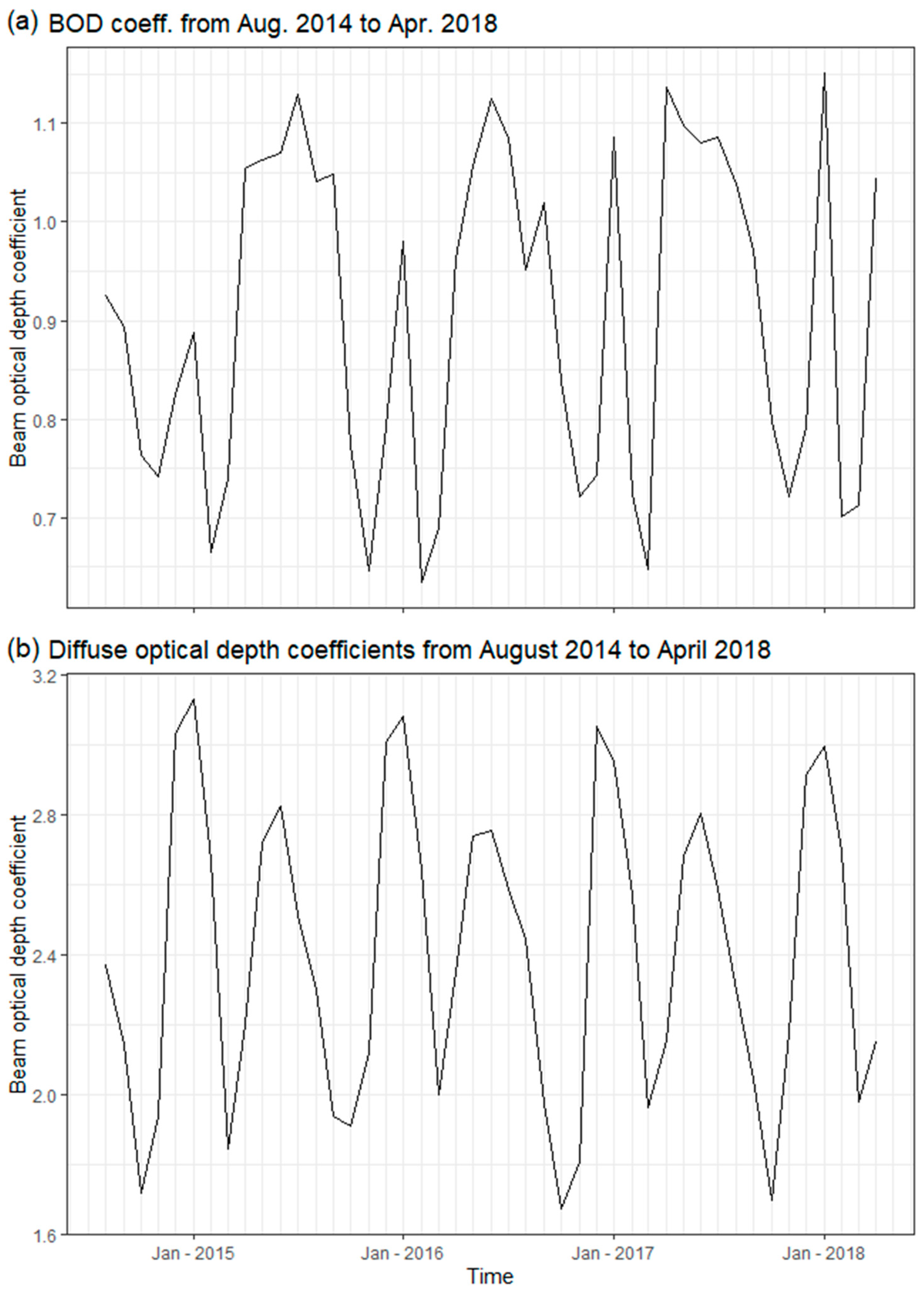
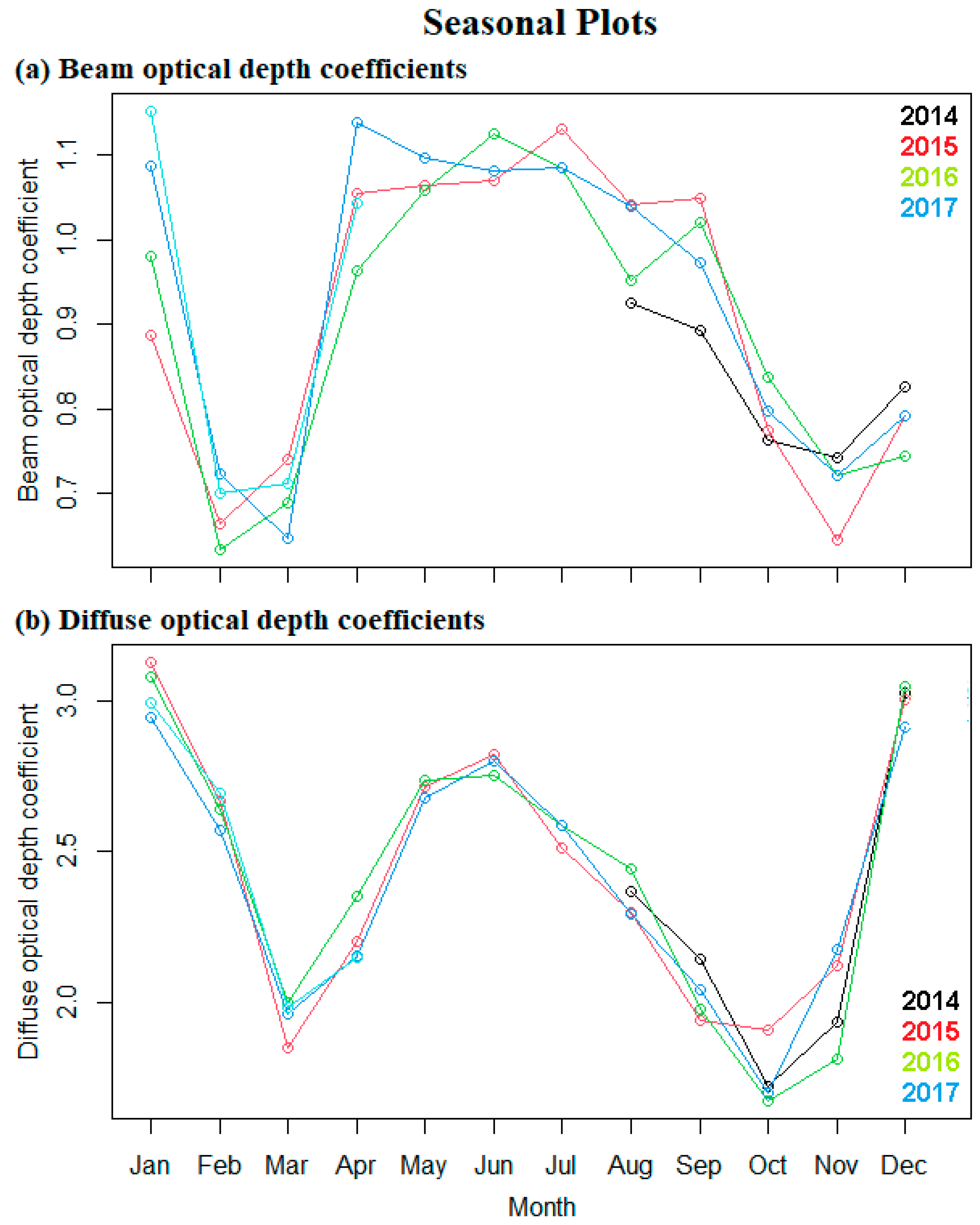
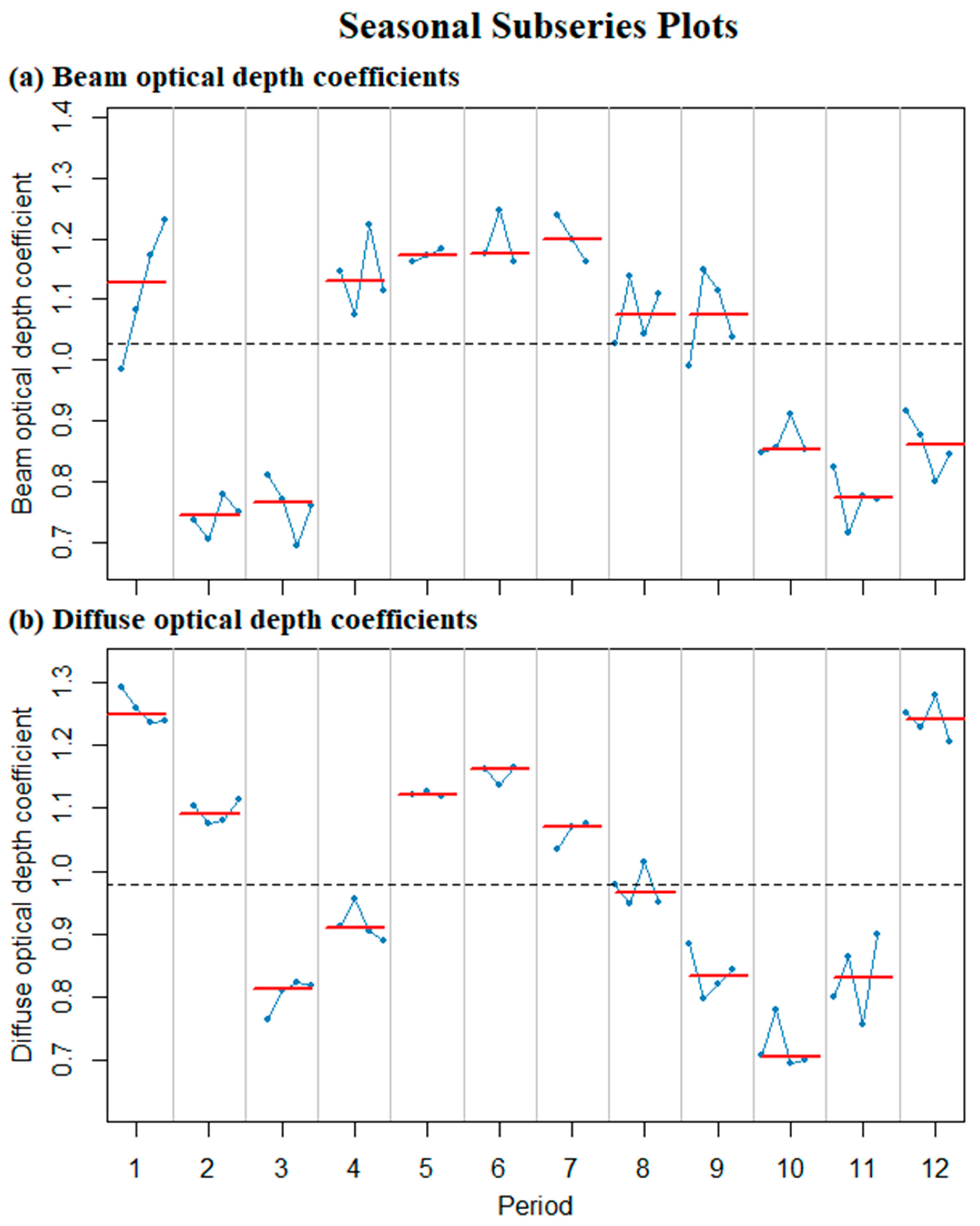

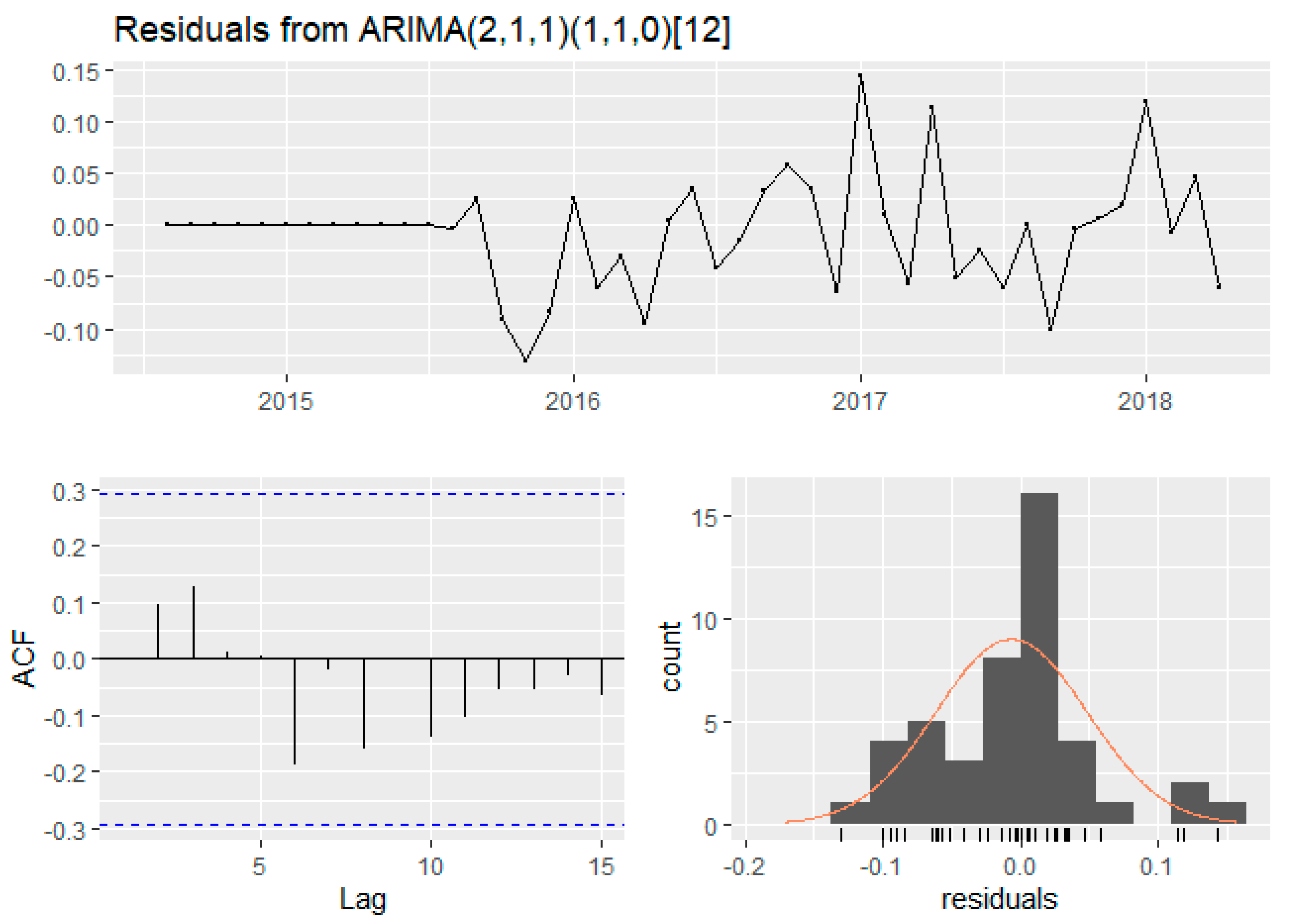
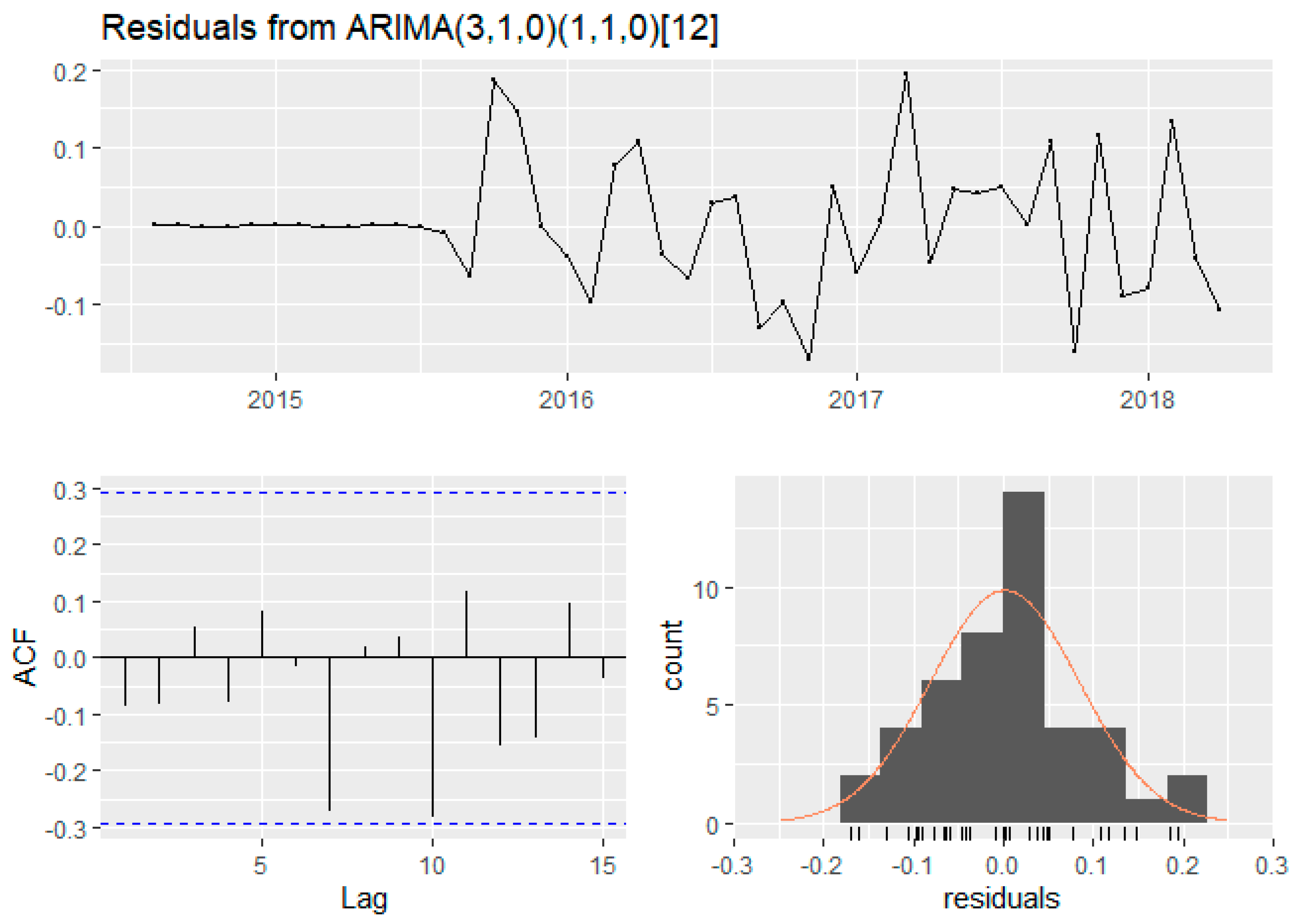

| Statistic Parameters | Beam Optical Depth | Diffuse Optical Depth | ||||
|---|---|---|---|---|---|---|
| Naive Method | ETS Model | ARIMA Model | Naive Method | ETS Model | ARIMA Model | |
| Q | 9.6967 | 14.684 | 4.7057 | 12.665 | 28.608 | 5.7502 |
| df | 9 | 3 | 5 | 9 | 3 | 5 |
| p-value | 0.3756 | 0.0021 | 0.4528 | 0.1784 | 2.7 × 10−6 | 0.3313 |
| Model df | 0 | 14 | 4 | 0 | 14 | 4 |
| Total lags used | 9 | 17 | 9 | 9 | 17 | 9 |
| Test | Beam Optical Depth | Diffuse Optical Depth | ||||
|---|---|---|---|---|---|---|
| Naive Model | ETS Model | ARIMA Model | Naive Method | ETS | ARIMA Model | |
| MPE | 106.40 | 0.2611 | −1.1330 | −54.724 | −0.1012 | −0.0026 |
| MAE | 0.0843 | 0.0383 | 0.0368 | 0.1433 | 0.0605 | 0.0586 |
| MAPE | 166.72 | 4.2783 | 4.1807 | 108.62 | 2.7253 | 2.7009 |
| RMSE | 0.0981 | 0.0490 | 0.0547 | 0.1859 | 0.0757 | 0.0819 |
| MASE | 1 | 0.6155 | 0.5913 | 1 | 0.5726 | 0.5551 |
| Component | Area (m2) | Material | Surface Azimuth [0] | Surf. Tilt from Horiz. [0] |
|---|---|---|---|---|
| Roof | 14.00 | New sheet metal galvanized roof surface. | −45 | 0 |
| Wall | 4.00 | White acrylic paint surface wall. | −45 | 90 |
| Window | 6.00 | Single glazing-type 5d6 window system. | −45 | 90 |
| Local Std. Hour (Hrs) | Wall and Window Solar Irradiance (W) | Roof Solar Irradiance (W) | Wall Cooling Load (W) | Window Cooling Load (W) | Roof Cooling Load (W) | Total Cooling Load (W) |
|---|---|---|---|---|---|---|
| 0 | 0 | 0 | 6.8894 | 81.8090 | 11.9367 | 100.6351 |
| 1 | 0 | 0 | 5.9455 | 64.7724 | 10.5787 | 81.2966 |
| 2 | 0 | 0 | 5.0594 | 48.2553 | 9.3571 | 62.6718 |
| 3 | 0 | 0 | 4.2717 | 35.7263 | 8.4919 | 48.4900 |
| 4 | 0 | 0 | 3.6275 | 28.2710 | 7.8926 | 39.7911 |
| 5 | 102.6300 | 44.0217 | 3.1146 | 194.0213 | 7.3696 | 204.5055 |
| 6 | 353.8490 | 160.6268 | 2.9747 | 816.7486 | 8.7377 | 828.4611 |
| 7 | 412.0918 | 319.5139 | 3.8572 | 1105.1196 | 14.8966 | 1123.8734 |
| 8 | 370.0991 | 478.6413 | 5.9839 | 1041.6774 | 28.1285 | 1075.7898 |
| 9 | 270.4189 | 613.8186 | 8.6754 | 731.4266 | 46.2352 | 786.3372 |
| 10 | 140.5037 | 708.6097 | 11.1200 | 442.3355 | 65.8183 | 519.2739 |
| 11 | 298.5987 | 755.0025 | 12.8998 | 596.4177 | 83.7919 | 693.1094 |
| 12 | 116.6168 | 741.0646 | 14.3917 | 370.7617 | 97.0910 | 482.2444 |
| 13 | 106.8468 | 675.2933 | 15.5691 | 300.0449 | 104.5589 | 420.1729 |
| 14 | 93.1774 | 562.2877 | 16.0585 | 259.4217 | 105.5651 | 381.0453 |
| 15 | 75.9243 | 414.8976 | 16.2188 | 235.6355 | 100.6220 | 352.4763 |
| 16 | 56.0850 | 252.3353 | 16.2377 | 206.5021 | 89.9904 | 312.7303 |
| 17 | 35.0694 | 103.9000 | 15.9242 | 173.3563 | 74.1284 | 263.4089 |
| 18 | 19.9962 | 39.7395 | 15.1109 | 146.9955 | 55.7983 | 217.9047 |
| 19 | 0 | 0 | 13.8759 | 118.2320 | 39.7908 | 171.8987 |
| 20 | 0 | 0 | 12.3557 | 103.6728 | 27.8380 | 143.8666 |
| 21 | 0 | 0 | 10.7259 | 95.8722 | 20.1479 | 126.7460 |
| 22 | 0 | 0 | 9.2052 | 92.1492 | 15.8262 | 117.1807 |
| 23 | 0 | 0 | 7.9439 | 87.5994 | 13.5509 | 109.0942 |
Publisher’s Note: MDPI stays neutral with regard to jurisdictional claims in published maps and institutional affiliations. |
© 2022 by the authors. Licensee MDPI, Basel, Switzerland. This article is an open access article distributed under the terms and conditions of the Creative Commons Attribution (CC BY) license (https://creativecommons.org/licenses/by/4.0/).
Share and Cite
Mutombo, N.M.-A.; Numbi, B.P. The Development of ARIMA Models for the Clear Sky Beam and Diffuse Optical Depths for HVAC Systems Design Using RTSM: A Case Study of the Umlazi Township Area, South Africa. Sustainability 2022, 14, 3662. https://doi.org/10.3390/su14063662
Mutombo NM-A, Numbi BP. The Development of ARIMA Models for the Clear Sky Beam and Diffuse Optical Depths for HVAC Systems Design Using RTSM: A Case Study of the Umlazi Township Area, South Africa. Sustainability. 2022; 14(6):3662. https://doi.org/10.3390/su14063662
Chicago/Turabian StyleMutombo, Ntumba Marc-Alain, and Bubele Papy Numbi. 2022. "The Development of ARIMA Models for the Clear Sky Beam and Diffuse Optical Depths for HVAC Systems Design Using RTSM: A Case Study of the Umlazi Township Area, South Africa" Sustainability 14, no. 6: 3662. https://doi.org/10.3390/su14063662
APA StyleMutombo, N. M.-A., & Numbi, B. P. (2022). The Development of ARIMA Models for the Clear Sky Beam and Diffuse Optical Depths for HVAC Systems Design Using RTSM: A Case Study of the Umlazi Township Area, South Africa. Sustainability, 14(6), 3662. https://doi.org/10.3390/su14063662





